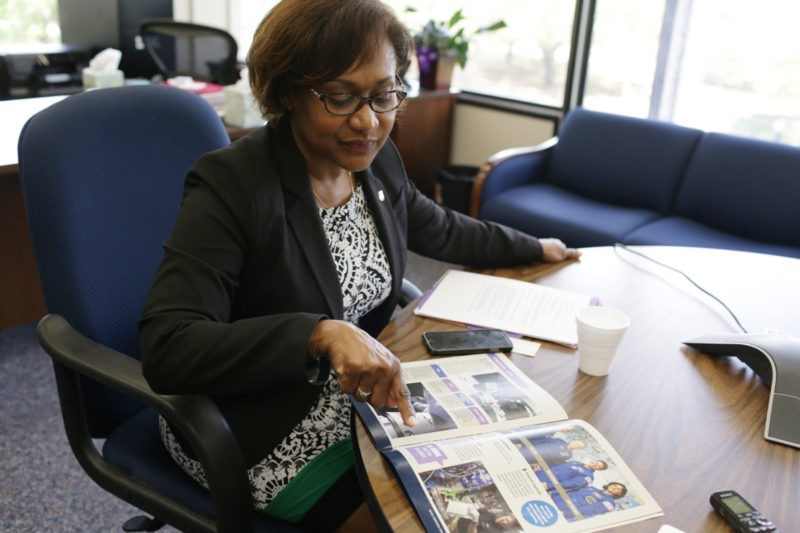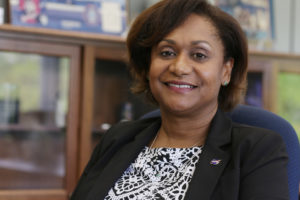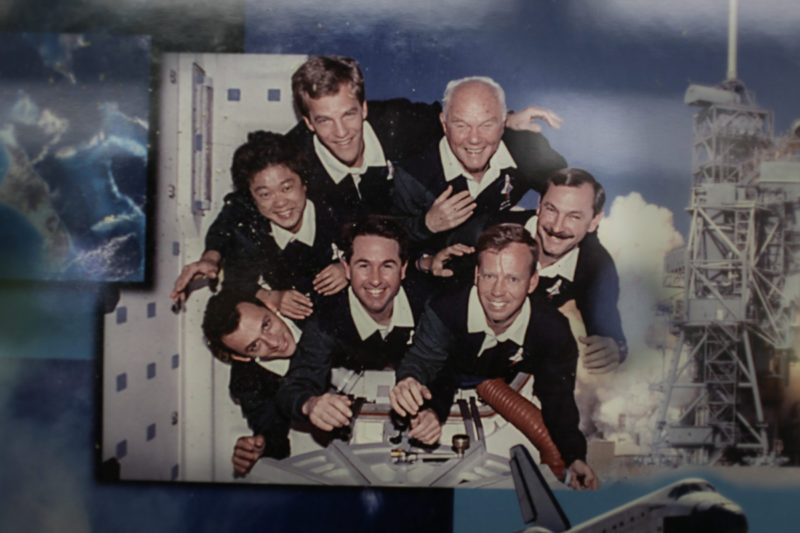Science, and Chance, Propelled African-American Engineer to NASA
By Louise Rodriguez
Reporting Texas

Vanessa Wyche is NASA’s director of exploration integration and science. She once worked with famed astronaut John Glenn. Kara Henderson/Reporting Texas
HOUSTON — Vanessa Wyche and her team send rodents to outer space, test whether travelers to Mars will stay sane and seek out the origins of life in extraterrestrial dirt. It’s a long way from small-town South Carolina.
“So, how did I get interested in science is what most people want to know,” Wyche said during a recent interview in her office at the Johnson Space Center.
Her list of influences is long, and it includes a chemistry set her brother received for Christmas, her parents’ support for any activity she and her siblings showed interest in, and the high school biology teacher whom she still talks to today.

NASA scientist Vanessa Wyche regularly volunteers time to speak with high school students about getting involved in STEM programs. Kara Henderson/Reporting Texas
As director of exploration integration and science at NASA’s sprawling center in Houston, Wyche, 53, has risen to one of the highest rungs in the engineering world. It’s no small feat for anyone, but especially for an African-American woman. The proportion of African-American and other minority women scientists in the country remains low today. As of 2015, one in 10 women who work in the nation’s science and technology sector are minority, according to the National Science Foundation.
While colleges across the United States are making efforts to recruit minorities to engineering programs, some wonder if it’s enough. At the University of Texas at Austin, African-Americans represent roughly 2 percent of enrolled engineering students, down from 3.6 percent in 1995. At UT as a whole, African-Americans represented roughly 5 percent of all undergraduates in 2016, up from about 4 percent in 1996.
Wyche said Clemson University sought her out as a high school student in her home state of South Carolina.
Clemson “was not on my radar screen as a teen,” Wyche said. “They sent information on their program to me. Once I got there, I found out several of my African-American friends had attended a summer enrichment program on campus during their junior year in high school.”
Wyche recently went back to visit Clemson and found that the president of the university is making higher African-American enrollment a priority, increasing student outreach and retention efforts.
After a successful career in engineering, Wyche has some suggestions about how to improve the recruitment of minority students. Colleges must make a concerted effort to reach and retain African-American students who excel in science, technology, engineering or math, she said. Retention is important, Wyche said, because it increases the number of African-Americans in the program and produces “ambassadors” for further recruitment.
A goal of UT’s Cockrell School’s Equal Opportunity in Engineering program is to mirror the proportion of African-Americans among all college-age students in Texas, which is 12 percent, according to EOE Director Enrique Dominguez. The program currently recruits underrepresented students of all types, rather than focusing on a single demographic.
Students such as Jade Jackson, a senior in UT’s chemical engineering program and chapter president of the National Society of Black Engineers, are asking the Cockrell School to concentrate on the drop in African-American engineering student enrollment at a time when overall African-American enrollment has increased, if slightly, at the university.
“The only numbers that actually are not changing, that actually need to be addressed, are black students,” Jackson said.
This year’s Oscar-nominated film “Hidden Figures” surprised audiences who didn’t realize that during the early 1960s space race, female black mathematicians were calculating astronauts’ way into the Earth’s orbit and beyond. At the time, it was exceedingly rate for women to work in science and math fields.
One of those astronauts was John Glenn, who decades later worked with Wyche when he volunteered at age 77 to join a 1998 Discovery mission. Despite the worries that the expedition might endanger a national hero, Wyche, as payload manager, and her fellow engineers grabbed the rare chance to compare biological data from Glenn with the medical history NASA had preserved during his historic flight in 1962.
“He was amazing,” she said, turning to admire a large framed picture behind her of the STS-95 crew, Glenn among them, floating in the hatchway area of the ship. “He trained harder than any of the younger people.”

Hanging in Wyche’s office are several iconic photographs of NASA astronauts and mission crews. Pictured here is the 1998 crew of the space shuttle Discovery. During that mission, John Glenn became the oldest man to fly in space. Kara Henderson/Reporting Texas
The picture was propped up on a bookshelf in Wyche’s office, which is in an austere mid-century building labeled “Johnson Space Center” above its entry. An iconic light-blue NASA logo painted on the pavement outside its sliding glass doors is Building 1’s welcome mat.
In nearly an hour-long interview, Wyche rarely dropped her professional mask, except to laugh when reminiscing about her early life.
She had been in the gifted and talented program at her public high school in the small resort town of Conway, South Carolina, and in her junior year she attended the Governor’s School, a summer program for top high school students. Graduating a year early and as the first of her four other siblings to attend an integrated school system all the way from kindergarten onward, Wyche went on to the predominantly white Clemson.
When she started in 1981, only about 15 years had passed since Clemson had allowed black students to attend.
“It was obvious in some classes that some of the professors were not all that excited about having women and/or minorities in the classrooms,” Wyche said.
A bachelor’s degree in materials engineering and a master’s in bioengineering in hand, Wyche started her career as a medical device evaluator with the Food and Drug Administration in Washington, D.C. Then she met her future husband, who moved her to his hometown of Houston, which meant she had to look for a new job.
“A lot of people I meet, their whole life they want to work at NASA,” Wyche said, describing her opportunity.
Years before, one of NASA’s most tragic events had stuck in her mind: the 1986 Challenger explosion in which all crew members perished. An astronaut on that mission was Ron McNair, who grew up 30 miles from Wyche’s hometown and was a hero to many South Carolinians. When Wyche started at NASA, her mother’s reaction was: “Oh, please don’t be an astronaut.”
She isn’t an astronaut. Instead, she sends plants, equipment and other materials into zero gravity to see how they respond. Wyche knows about plants from childhood summers on her grandparents’ tobacco farm, cultivating vegetables on the plot of land her grandfather gave her.
“The family farm: That is the genesis of the hard work gene,” she said with a lilt to her voice.
At NASA, Wyche created new crops of things on the ground—solar arrays and other parts to build the International Space Station—that have gone into orbit and, if necessary, returned successfully to Earth.
The leadership skills needed for her new role directing the research and strategies for space flight are something she’d like to pass on to students interested in science. Over the last five years, Wyche and other NASA engineers in a program called Emerge have stepped in to do hands-on projects with a local elementary school that lost its science fair funding.
Wyche said the school’s principal recently told her that science scores have risen “a significant amount” since Emerge began, and she is certain that the program’s mentorship will produce future engineers.
“With ‘Hidden Figures’—it was seeing these women on the screen and seeing that this is something that could be done,” Wyche said. “And it’s that connection between seeing and believing and then doing something.”